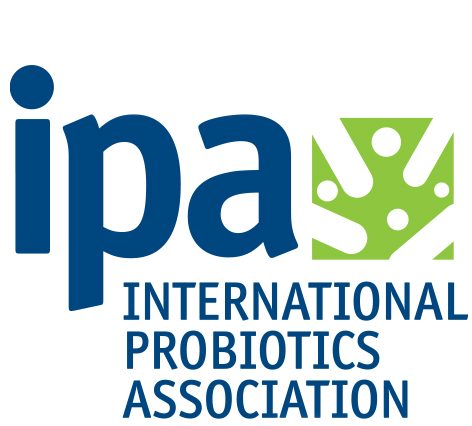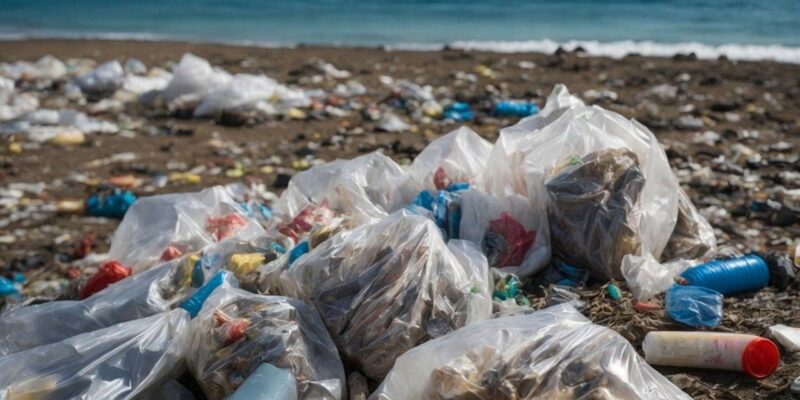Three times the size of France, the Great Pacific Garbage Patch —a mass of plastic debris— floats in the ocean. Due to limited recycling (less than 5%) and ubiquity across industry and packaging, plastics — and their degradation products— have contaminated the earth’s waters, land, and atmosphere.
Humans are exposed to smaller breakdown products including microplastics and nanoplastics primarily through ingestion, inhalation, and contact with the skin. This raises significant concerns regarding potential long-term health risks. Recent studies have emphasized the potential adverse impacts of microplastics and nanoplastics exposure on gut microbiota and immune response.
This blog addresses those concerns as well as the potential of probiotics to ameliorate harms.
Microplastics and nanoplastics (MNPs), in brief
Through biological, chemical, and environmental elements, plastics degrade into different sizes of debris. Microplastics are fragments less than 5 mm in length while nanoplastics are considerably smaller, less than 0.1 μm or 1 μm (definition is still debated), and not visible to the human eye.
Humans are exposed by ingestion (e.g. dietary products, packaging), inhalation (e.g. dust and textiles), and outdoor air and skin contact (e.g. make-up, sunscreen, and hygiene products). Animal studies have observed that microplastics and nanoplastics can harm cells, trigger immune responses, carry harmful chemicals, and potentially transmit disease-causing pathogens like viruses. Harms include effects on growth, reproduction, the digestive tract, the nervous system and inflammatory pathways, among others. The toxic effects on human health require more research.
MNPs and the gut microbiota
Chronic exposure to microplastics may lead to dysbiosis of the gut microbiota through mechanical disruption and ingestion of pathogens and microplastic-adhering chemicals, according to research on many animal species.
Dysbiosis has the potential to disrupt the host immune system, initiating the development of chronic diseases, fostering pathogenic infections, and modifying the gene capacity and expression within the gut microbiota.
MNPs and immune response
In vivo studies have demonstrated that exposure to MNPs can lead to immunotoxic effects in both invertebrates and vertebrates. These effects include alterations in immune cell function, changes in gene expression, and disturbances in various immune parameters. Studies have shown that ingested microplastics accumulate in the gut, causing inflammation and immune effects. Smaller particles (nanoplastics) can cross the mucus barrier and reach organs, even the brain. Airborne microplastics also impact the digestive tract and immune system.
MNPs and the gut epithelium
Various in vivo studies have investigated the impact of MNP exposure on the gut epithelium in different organisms, such as nematodes, zooplankton, mussels, fish, and mice. These studies have revealed diverse effects, including intestinal oxidative damage, cellular deformations, inflammation, alterations in enzyme activities, and changes in gene expression, indicating potential harm to the gut epithelium.
MNPs’ exposure on the gut microbiota
Numerous studies have investigated the effects of microplastic exposure on the gut microbiota in different animal species. Shifts in microbial diversity and composition have been observed consistently. The specific changes vary among species, but the overall dysbiosis is likely to impact the immune system’s functionality.
Microplastics as carriers of intestinal toxics and pathogens
Microplastics contain additives and can adsorb contaminants, including phthalates, bisphenol A, and many others. These pollutants in or on microplastics may enhance their toxicity. Additionally, microplastic biofilms can harbor potentially harmful bacterial pathogens, which may have implications for human health.
Human health considerations
One study in humans observed a positive correlation between the concentration of fecal microplastics and the severity of inflammatory bowel disease (linked to gut microbiota dysbiosis). An accompanying questionnaire pointed to plastic food and water packaging as well as dust exposure as significant sources of microplastics for the participants.
Researchers believe that while definitive evidence linking MNPs consumption to human health is currently lacking, results from animal and cell culture experiments suggest that MNPs may result in harmful effects “including provoking immune and stress responses and inducing reproductive and developmental toxicity.” Gut microbiota dysbiosis is one observed pathophysiology, which could cascade into various negative outcomes across the arc of systems. Several diseases such as obesity, diabetes, colorectal cancer, and inflammatory bowel disease have become much more prevalent since the widespread adoption of plastics in the 1950s. Of course, these diseases are caused by many factors but the increased exposure to MNPs may be contributing to the surge in rates. Much more research is needed.
Potential for probiotics?
Modulation of the gut microbiota through the use of probiotics may be beneficial in protecting against MNPs damages.
Researchers suggest probiotics may counteract the toxic effects of MNPs on gut microbiota through several mechanisms, such as reinforcing the intestinal barrier, promoting the production of cytokines, chemokines, and IgA-secreting cells, normalizing microbial communities, producing beneficial fatty acids, modulating anti-inflammatory responses, and potentially influencing the brain-gut axis.
Animal studies
A 2023 study tested probiotics in mice with spermatogenic (sperm cell production) injury induced by polystyrene microplastics. A probiotic mixture of lactobacilli, Bifidobacterium, and Enterococcus given orally mitigated the inflammatory response and lessened the sperm quality decline caused by microplastics.
Another recent study found that probiotics supplementation significantly ameliorated nanoplastic-induced hematopoietic (red blood cell production) damage in mice by modulating specific gut microbes.
Further research is required to substantiate the efficacy of probiotics in reducing MNP toxicity in humans.
Takeaway
Plastic waste has vastly increased since the 1950s when widespread use in every industry along with limited recycling has led to environmental contamination. Improving this should be the immediate focus. However, that is not going to address the historical burden which is responsible for the current exposure to MNPs. Studies on animals reveal potential harm from microplastics and nanoplastics to the gut microbiota, immune response, and gut epithelium. However, there is limited human data available. Probiotics show promise in mitigating some of these effects in animals, but their efficacy in humans requires further investigation. Addressing plastic pollution is crucial for safeguarding human health and the environment, and more research is needed to understand the full extent of microplastic and nanoplastic impacts on humans.
Image by Pete Linforth from Pixabay
Key References
Bazeli, Javad et al. “Could probiotics protect against human toxicity caused by polystyrene nanoplastics and microplastics?.” Frontiers in nutrition vol. 10 1186724. 10 Jul. 2023, doi:10.3389/fnut.2023.1186724
Blackburn, Kirsty, and Dannielle Green. “The potential effects of microplastics on human health: What is known and what is unknown.” Ambio vol. 51,3 (2022): 518-530. doi:10.1007/s13280-021-01589-9
Campanale, Claudia et al. “A Detailed Review Study on Potential Effects of Microplastics and Additives of Concern on Human Health.” International journal of environmental research and public health vol. 17,4 1212. 13 Feb. 2020, doi:10.3390/ijerph17041212
Deng, Yongfeng et al. “Microplastics release phthalate esters and cause aggravated adverse effects in the mouse gut.” Environment international vol. 143 (2020): 105916. doi:10.1016/j.envint.2020.105916
Fackelmann, Gloria, and Simone Sommer. “Microplastics and the gut microbiome: How chronically exposed species may suffer from gut dysbiosis.” Marine pollution bulletin vol. 143 (2019): 193-203. doi:10.1016/j.marpolbul.2019.04.030
Gigault, Julien et al. “Current opinion: What is a nanoplastic?.” Environmental pollution (Barking, Essex : 1987) vol. 235 (2018): 1030-1034. doi:10.1016/j.envpol.2018.01.024
Hirt, Nell, and Mathilde Body-Malapel. “Immunotoxicity and intestinal effects of nano- and microplastics: a review of the literature.” Particle and fibre toxicology vol. 17,1 57. 12 Nov. 2020, doi:10.1186/s12989-020-00387-7
Liu, Weijia et al. “Toxicological effects of micro/nano-plastics on mouse/rat models: a systematic review and meta-analysis.” Frontiers in public health vol. 11 1103289. 18 May. 2023, doi:10.3389/fpubh.2023.1103289
Plaza-Diaz, Julio et al. “Mechanisms of Action of Probiotics.” Advances in nutrition (Bethesda, Md.) vol. 10,suppl_1 (2019): S49-S66. doi:10.1093/advances/nmy063
Prata, Joana Correia et al. “Environmental exposure to microplastics: An overview on possible human health effects.” The Science of the total environment vol. 702 (2020): 134455. doi:10.1016/j.scitotenv.2019.134455
Prata, Joana Correia. “Airborne microplastics: Consequences to human health?.” Environmental pollution (Barking, Essex : 1987) vol. 234 (2018): 115-126. doi:10.1016/j.envpol.2017.11.043
Prüst, Minne et al. “The plastic brain: neurotoxicity of micro- and nanoplastics.” Particle and fibre toxicology vol. 17,1 24. 8 Jun. 2020, doi:10.1186/s12989-020-00358-y
Tang, Yu et al. “Immunotoxicity and neurotoxicity of bisphenol A and microplastics alone or in combination to a bivalve species, Tegillarca granosa.” Environmental pollution (Barking, Essex : 1987) vol. 265,Pt A (2020): 115115. doi:10.1016/j.envpol.2020.115115
Weiss, G Adrienne, and Thierry Hennet. “Mechanisms and consequences of intestinal dysbiosis.” Cellular and molecular life sciences : CMLS vol. 74,16 (2017): 2959-2977. doi:10.1007/s00018-017-2509-x
Yan, Zehua et al. “Analysis of Microplastics in Human Feces Reveals a Correlation between Fecal Microplastics and Inflammatory Bowel Disease Status.” Environmental science & technology vol. 56,1 (2022): 414-421. doi:10.1021/acs.est.1c03924
Yang, Yuyi et al. “Microplastics provide new microbial niches in aquatic environments.” Applied microbiology and biotechnology vol. 104,15 (2020): 6501-6511. doi:10.1007/s00253-020-10704-x
Zhang, Lei et al. “Melatonin and probiotics ameliorate nanoplastics-induced hematopoietic injury by modulating the gut microbiota-metabolism.” Nano research vol. 16,2 (2022): 2885-2894. doi:10.1007/s12274-022-5032-9
Zhang, Yecui et al. “Probiotics improve polystyrene microplastics-induced male reproductive toxicity in mice by alleviating inflammatory response.” Ecotoxicology and environmental safety, vol. 263 115248. 11 Jul. 2023, doi:10.1016/j.ecoenv.2023.115248
Zhang, Yunchang et al. “Association between intestinal microbiota and inflammatory bowel disease.” Animal models and experimental medicine vol. 5,4 (2022): 311-322. doi:10.1002/ame2.12255

